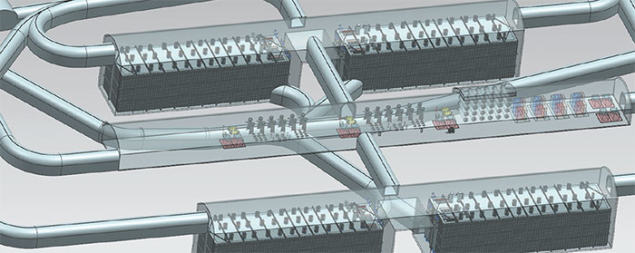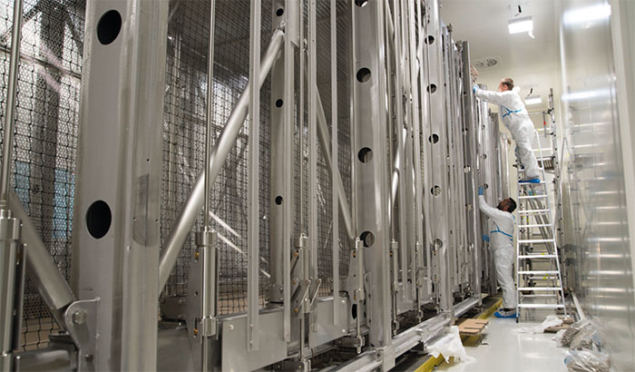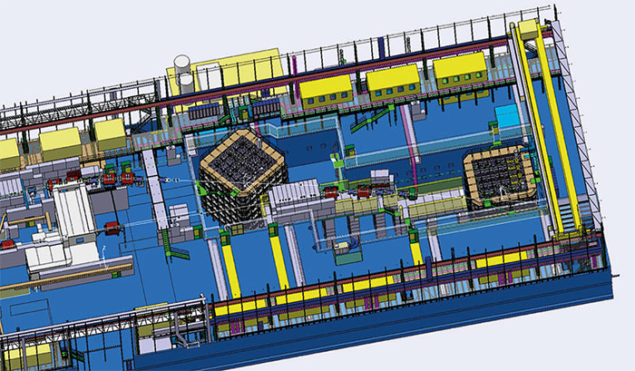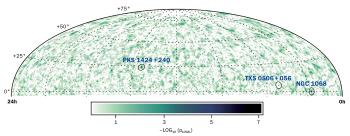The CERN Neutrino Platform supports global neutrino experiments.

Image credit: Fermilab.
When CERN was founded in 1954, the neutrino was technically still a figment of theorists’ imaginations. Six decades later, neutrinos have become the most studied of all elementary particles. Several new and upgraded neutrino-beam experiments planned in Japan and the US, in addition to the reactor-based JUNO experiment in China, aim to measure vital parameters such as the ordering of the neutrino masses and potential CP-violating effects in the neutrino sector. In support of this effort, CERN is mounting a significant R&D programme called the CERN Neutrino Platform to strengthen European participation in neutrino physics.
CERN has a long tradition in neutrino physics. It was the study of neutrino beams with the Gargamelle detector at CERN in 1973 that provided the first evidence for the weak neutral current, and in the late 1970s, three experiments – BEBC, CDHS and CHARM – used a beam from the SPS to further unveil the neutrino’s identity. A milestone came in 1989, when precise measurements at the Large Electron–Positron Collider showed that there are three, and only three, types of light neutrinos that couple to the Z boson. This was followed by searches for neutrino oscillations at NOMAD (also known as WA96) and CHORUS (WA95) during the 1990s, which were eventually established by the Super-Kamiokande collaboration in Japan and the Sudbury Neutrino Observatory in Canada. More recently, from 2006 to 2012, CERN sent a muon-neutrino beam to the ICARUS and OPERA detectors at the Gran Sasso National Laboratory, 732 km away in Italy. The main goal was to observe the transformation of muon neutrinos into tau neutrinos, which was confirmed by the OPERA collaboration in 2015.
Following the recommendations of the European Strategy for Particle Physics in 2013, CERN inaugurated the neutrino platform at the end of 2014. Its aim is to provide a focal point for Europe’s contributions to global neutrino research by developing and prototyping the next generation of neutrino detectors. So far, around 50 European institutes have signed up as members of the neutrino platform, which sees CERN shift from its traditional role of providing neutrino beams to one where it shares its expertise in detectors, infrastructure and international collaboration.
“The neutrino platform pulls together a community that is scattered across the world and CERN has committed significant resources to support R&D in all aspects of neutrino research,” says project leader Marzio Nessi. Specifically, he explains, CERN is using the organisational model of the LHC to help in
developing an international project on US soil and to contribute to neutrino programmes in Japan and elsewhere. “This is precisely what CERN is about,” says Nessi. “The platform provides a structure at CERN to foster active involvement of Europe and CERN in the US and Japanese facilities.”

Image credit: CERN.
In December 2014, CERN and the Italian National Institute for Nuclear Physics (INFN) took delivery of the 760 tonne ICARUS detector, which formerly was located at Gran Sasso. The detector is currently being refurbished by the neutrino platform’s WA104 team and in 2017 it will be shipped to Fermilab in the US to become part of a dedicated short-baseline neutrino (SBN) programme there. This programme was approved following unexpected results from the LSND experiment at Los Alamos National Laboratory in the 1990s, which hinted at the existence of a fourth – possibly “sterile” – type of neutrino. The result was followed up by the MiniBooNE experiment at Fermilab, which also saw deviations – albeit different again – from the expected signal.
ICARUS will be installed just behind the previous MiniBooNE site, some 600 m downstream from the source of the beam at Fermilab’s booster ring. It will be the farthest of three detectors in the line of the beam after the Short Baseline Neutrino Detector (SBND, which is currently under design) and MiniBooNE’s successor MicroBooNE (which is already operational). All three detectors employ liquid-argon time projection chambers (LAr-TPCs) to study neutrino oscillations in detail. ICARUS comprises two 270 m3 modules filled with liquid argon: when an energetic charged particle passes through its volume it ionises the liquid and a uniform electric field causes electrons to drift towards the end plates, where three layers of parallel wire planes oriented at different angles (together with the drift time) allow researchers to reconstruct a 3D image of the event.
The refurbishing campaign at CERN concerns many parts of the ICARUS experiment: the photomultipliers, the read-out electronics, the cathode plane and the argon recirculating system. Moreover, it will benefit from European expertise in automatic event reconstruction and the handling of large data sets. Finally, the unique cryostat in which ICARUS will be placed is also being assembled at CERN. “Improving the performances of a detector already successfully operating in the Gran Sasso underground laboratory is extremely challenging in many respects,” says ICARUS technical co-ordinator Claudio Montanari. “Indeed, in order to make it fully functional to operate on surface, many different aspects including data acquisition, background rejection, timing and event reconstruction needed to be rethought.”
Going deeper

Image credit: CERN.
Rapid progress made in understanding neutrino oscillations during the past 15 years has also provided a strong case for long-baseline neutrino programmes. A major new international project called DUNE (Deep Underground Neutrino Experiment), which is estimated to begin operations by approximately 2026 as part of Fermilab’s Long Baseline Neutrino Facility (LBNF), will take the form of a near and a far multikiloton detector. The far detector will consist of four 10 kt active LAr-TPC modules sited in a 1.5 km-deep cavern at the Sanford lab in South Dakota, 1300 km away, at which neutrino beams with unprecedented intensities will be fired through the Earth from Fermilab. While the three experiments in the SBN programme will look for the disappearance of electron and muon neutrinos to search for sterile neutrinos, they will also serve as a stepping stone to the large LAr modules required by LBNF. The LBNF/DUNE experiment will allow not just the neutrino-mass hierarchy to be determined but also CP violation to be looked for in the leptonic sector, which could help to explain the missing baryonic matter in the universe.
The CERN Neutrino Platform is building two large-scale prototypes – single-phase and double-phase ProtoDUNE modules – to enable LAr detectors to be scaled up to the multikiloton level. The cryostat for such giant detectors is a particular challenge, and led physicists to explore a novel technological solution inspired by the liquified-natural-gas (LNG) shipping industry. CERN is currently collaborating with French firm Gaztransport & Technigaz, which owns the patent for a membrane-type containment system with two cryogenic liners that support and insulate the liquid cargo. Although this containment system has the advantage of being modular, the challenge in a particle-physics setting is that the cryostats not only have to contain the liquid argon but also all of the detectors and read-out electronics.
Global connection
While the single-phase ProtoDUNE detector uses technology that is very similar to that in ICARUS, a second neutrino-platform project called WA105 aims to prototype the new concept of a “dual-phase” LAr time projection chamber (DLAr-TPC), which is being considered for one or more of the DUNE far-detector 10 kt modules. In a DLAr chamber, a region of gaseous argon resides above the usual liquid phase. Ionisation electrons drift up through the detector volume and are accelerated into the gaseous region near the top of the cryostat by a strong electric field. Here, large electron multipliers amplify the signals, while the anode collects the charged particles and provides the spatial read-out. “The ProtoDUNE tests foreseen at the CERN Neutrino Platform represent the culmination of more than a decade of R&D towards the feasibility of very large liquid-argon time projection chambers for next-generation long-baseline experiments,” says André Rubbia, co-spokesperson of the DUNE collaboration.

Image credit: Fermilab.
ProtoDUNE and WA105 are planned to be ready for test beam by 2018 at a new EHN1 test facility currently under construction in the north area of CERN’s Prévessin site. Most of the civil-engineering work to extend the EHN1 building is complete and all components are under procurement or installation, with staff expected to move in towards the end of the year. The test facility was financed by CERN, with two beamlines due to be commissioned in late 2017.
As ICARUS prepares for its voyage across the Atlantic, and the detectors for the next-generation of US neutrino experiments takes shape, the CERN Neutrino Platform is also working on components for Japan’s neutrino programme (see “NOvA releases new bounds on neutrino mixing parameters”). The Baby-MIND collaboration aims to construct a muon spectrometer – a state-of-the-art prototype for a would-be Magnetized Iron Neutrino Detector (MIND) – and characterise it in a charged-particle beam at CERN. The system will be assembled at CERN during the winter and tested in May next year, before being shipped to Japan in the summer of 2017. Once there, it will become part of the WAGASCI experiment, where it will contribute to a better understanding of the systematics for the T2K neutrino and antineutrino oscillation analysis. Baby-MIND was approved by the CERN research board in December last year as a Neutrino Platform experiment. “Other projects for the Japanese neutrino programme are also under discussion,” says Baby-MIND spokesperson Alain Blondel of the University of Geneva.
Finally, in June it was decided that the CERN Neutrino Platform will also involve a neutrino-theory working group to strengthen the connections between CERN and the worldwide community and help to promote research in theoretical neutrino physics at CERN. “Fundamental questions in neutrino physics, such as the existence of leptonic CP violation, the Majorana nature of neutrinos and the origin of neutrino masses and mixings, will be at the centre of research activities,” explains group-convener Pilar Hernández. “The answers to these questions could have essential implications in other areas of high-energy physics, from collider physics to indirect searches, as well as in our understanding of the universe.”
• CERN Neutrino Platform: cenf.web.cern.ch.
• Theory working group: th-dep.web.cern.ch/cern-neutrino-platform-theory-working-group-cenf-th.
CERN Neutrino Platform: in summary
The CERN Neutrino Platform offers a unique opportunity to build a strong European neutrino community, with immediate physics potential coming from the short-baseline experiments at Fermilab in the US and the new near detector at T2K in Japan. The platform is also making a major contribution to the infrastructure of Fermilab’s Long-Baseline Neutrino Facility (LBNF), including the design and construction of a large LBNF cryostat to be placed underground at the Sanford Underground Research Facility, new large detector prototypes and generic R&D on new detectors and data handling. CERN and Europe will therefore participate fully in the construction, commissioning and physics exploitation of the new high-intensity facility. In addition to R&D for the LBNF/DUNE cryostat, the neutrino platform currently has five approved participants:
• WA104, ICARUS far detector for Fermilab’s short-baseline programme;
• WA105, the engineering prototype for a double-phase LAr-TPC;
• PLAFOND, a generic R&D framework;
• ProtoDUNE, the engineering prototype for a single-phase LAr-TPC;
• BabyMIND, a muon spectrometer for the WAGASCI experiment.







